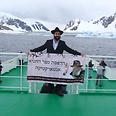
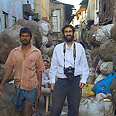
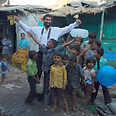
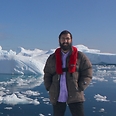
After exploring close to 40 countries in five continents, and being forced to change two passports due to too many stamps, Meir Alfasi's travel instinct is alive and kicking.
Alfasi, a Chabad photographer who serves as a "roaming emissary" spreads Judaism in the most remote places across the globe. A Hasidic backpacker who runs around every place possible with tefillin, the "Tanya" book – and a camera.
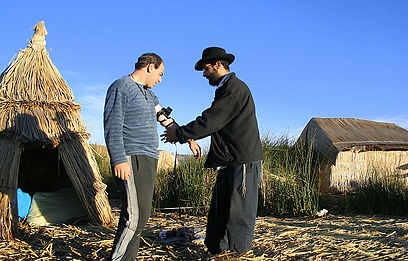
'In the Bolivia jungle an Israeli touched me to make sure I was real' (Photo: Meir Alfasi)
I tried to interview Alfasi several times, unsuccessfully. It's hard getting hold of a person who is one moment here, and the next moment at the Rajasthan deserts or in the middle of Peru's jungles.
Even as we spoke, he was busy filling his backpack with kosher food, tefillin and a printer, before heading to Mongolia where he was planning to locate lost Jews and print out the "Tanya" book – the bible of the Chabad Hasidic movement – for them.
Tourist attraction
He began wandering around the world at the age of 16, when he traveled to New York like other Chabadniks.
"I decided to stop in Europe due to budget constraints, and then I said to myself, 'If I'm already there, why don't I tour the area for a few days?' Since then I've been addicted," he admits. "The feeling of roaming the world and meeting people and different cultures was a developing experience. But at the time I still didn't know I would be taking it along with me."
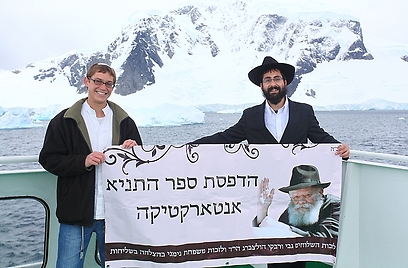
Off to Antarctica to print 'Tanya' for Jewish researchers (Photo: Meir Alfasi)
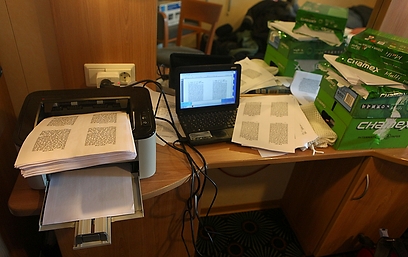
The goal – not to leave one Jew in a place with no 'Tanya' (Photo: Meir Alfasi)
Indeed, a normal "day at the office" includes, many times, a 20-hour bus ride in a third world country, waiting for another "blind date" with an Israeli or a Jew. The surprise effect of an Orthodox Jew in the middle of the jungle is never disappointing.
"I meet Israelis or Jews while on track, and suggest that they lay tefillin. The first response is shock. In the Bolivian jungle, one Israeli actually touched me to make sure that I was real and not a hallucination."
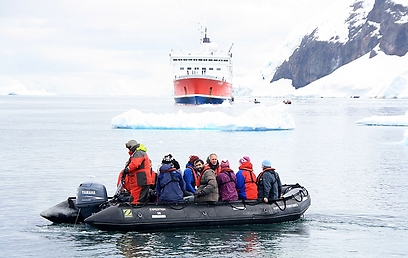
Connecting with Israelis on way to Antarctica (Photo: Meir Alfasi)
Alfasi has a habit of choosing the most remote location in the area he arrives in, and trying to get people to lay tefillin there or print the "Tanya."
"Take the floating islands on the Peru-Bolivia border, for example. I decided that I would put tefillin on someone there. In the tourist boat I asked for the loudspeaker, and declared in Hebrew, English and Spanish that if there were any Jews who wanted to lay tefillin – they should come to me.
"One approached me, and I put tefillin on him in front of the Indians sitting outside the cabins and watching us. The tourists around us took pictures of us and of the natives. For him and for me, a Jewish act in a place so far from Jewish existence was a very emotionally moving and unique moment."
'Exclusion of women' on way to Antarctica
Never mind laying tefillin, but printing the "Tanya"? Alfasi explains that the Lubavitcher Rebbe said the book must be printed anywhere in the world where there are Jews.
"The 'Tanya' has been printed in Lebanon and Iran, as well as in isolated areas in South America where there are still Jews. One of my aspirations is to ensure that there is no Jew left in a place where there is no 'Tanya.'"
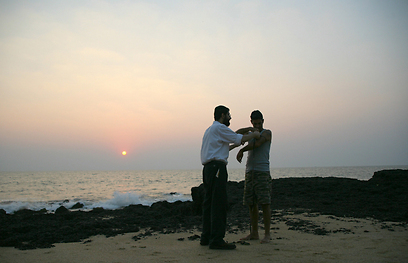
'A Jewish act at a place so far from Jewish existence is a moving moment' (Photo: Meir Alfasi)
This decision led Alfasi to embark on a unique trip to Antarctica recently, and print the book there for Jewish researchers living in the continent's research stations.
"On the ship I discovered three Israeli hikers from Haifa, who didn't even want to talk to me at first," he recalls. "Israel was caught up in the 'exclusion of women' scandal at the time, and the guys came there filled with negative feelings towards the haredim. At first I didn’t even know what they were talking about.
"I realized that something must have happened which really angered them, so I preferred to let it go. We spoke about nature – one of the my favorite things in the world – and that's how we connected. Suddenly they came on their own initiative to eat with me. We found the common denominator beyond the mess.
"One of the non-Jews there, with whom I also developed friendly relations, told me candidly: 'I can't stand Bibi (Prime Minister Benjamin Netanyahu), but I love you.' As the years go by, I understand that the human ability to connect and communicate has less to do with clothing or culture and more to do with human kindness. It works anywhere, anytime, with any person."
Best friend: Muslim photographer
Marriage and two children have failed to tame Alfasi. The most they've done is sharpen his level of alertness when taking risks. His only attempt to "settle down" was when he established the Chabad house in Goa, where he stayed for about half a year until his travel instinct kicked in again.
The period he spent preaching Judaism to Israeli hikers concluded, "traditionally," with a roam all around the subcontinent.
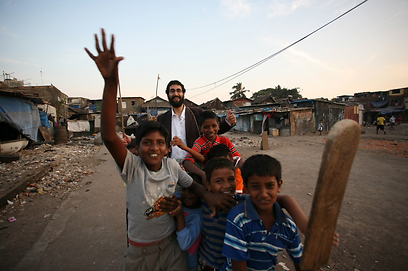
'The ability to connect has to do with human kindness rather than with culture' (Photo: Meir Alfasi)
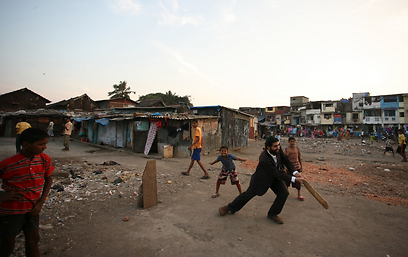
Alfasi at the Mumbai slums (Photo: Meir Alfasi)
"In India I met one of my best friends today – Adeel Halim, a Muslim Indian photographer," he says. "We met thanks to our shared profession, and then it continued to matters of Judaism as well. He asked about our religion, I visited his home and was exposed to his lifestyle, and the friendly relationship grew stronger.
"At the same time we thought of taking photos at the Chabad House in Mumbai, where the late Gabi and Rivki Holtzberg were, who I knew very well. I remember I presented them with the idea, but Gabi was afraid. There were rumors that the Chabad House was being targeted by assassins, and he wanted to keep a low profile, hoping it would go away."
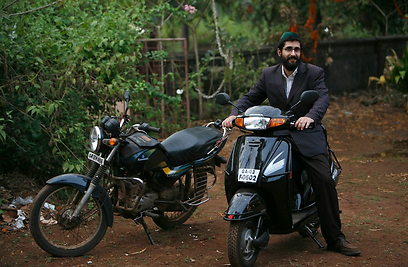
Photographer at the service of remote communities (Photo: Meir Alfasi)
Instead of the Chabad House, Alfasi found himself shooting a project with Halim for Reuters: A haredi Jew and a Muslim wandering around the slums of Mumbai and documenting the locals' life.
"When the terror attack occurred, I was there again as a photographer, and so was he. From within the ruins we spotted each other from both sides of the road. We left everything, ran and hugged each other while everyone around us was watching the odd couple, shocked."
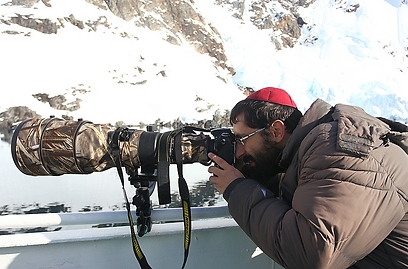
'Photographing nature is photographing God himself.' In Antarctica (Photo: Meir Alfasi)
Today Alfasi tries to devoutly combine his work as a photographer in the service of remote communities ("not so long ago I took pictures of the new community rabbi in Albania") while spreading Judaism in his unique extreme way. And of course, taking pictures of nature.
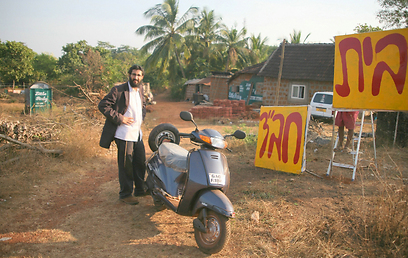
At Chabad House he established in Goa (Photo: Meir Alfasi)
"I see photographing nature as photographing God himself; the pure piece of life that the human hand hasn't touched. Nature strengthens me religiously. It's the most perfect and spiritual place there is. A high-quality trek combined with a lesson in Hasidism – and it all fits together in one winning frame."
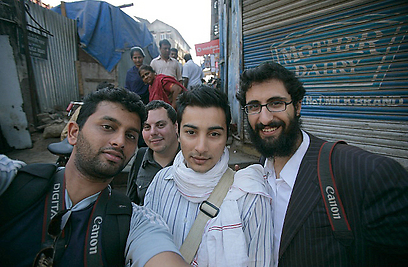
Haredi Jew and Muslim at Mumbai slums. With friends (Photo: Meir Alfasi)
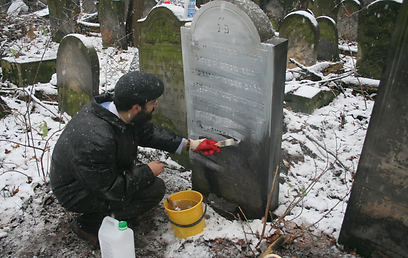
Renovating tombs in Poland (Photo: Meir Alfasi)
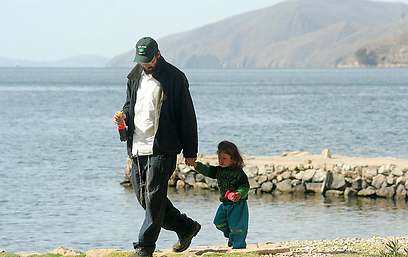
With his son (Photo: Meir Alfasi)















